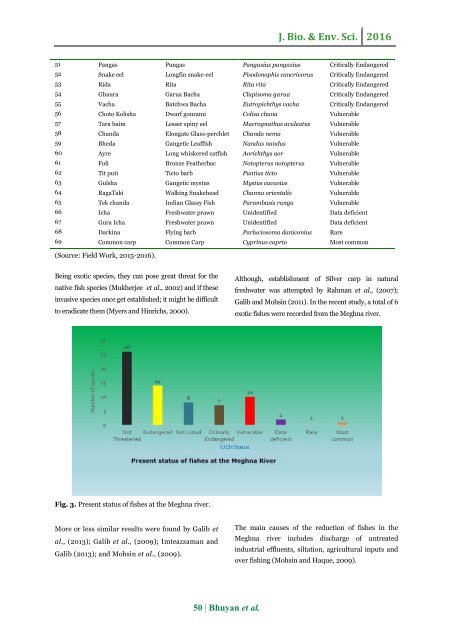Diversity status of fishes of the Meghna river adjacent to Narsingdi district, Bangladesh
The present experiment was conducted on the fish diversity of the Meghna River close to Narsingdi district from September, 2015 to March, 2016. Fish samples were collected from the fishermen for taxonomic study and thereby diversity of fishes was assessed. A total of 69 fish species were identified during the study under 23 orders and 28 families. Among 69 fish species; 26 were found belong to Cyprinidae family followed by Bagaridae (5), Schilbeidae (4), Channidae (4), Ambassidae (2), Belontiidae (3), Siluridae (2), Notopteridae (2), Mastacembelidae (2) and others (19). During the study period, 7 species were found critically endangered, 15 species were endangered and 12 species were vulnerable while 26 species were not found in threatened position.
The present experiment was conducted on the fish diversity of the Meghna River close to Narsingdi district from September, 2015 to March, 2016. Fish samples were collected from the fishermen for taxonomic study and thereby diversity of fishes was assessed. A total of 69 fish species were identified during the study under 23 orders and 28 families. Among 69 fish species; 26 were found belong to Cyprinidae family followed by Bagaridae (5), Schilbeidae (4), Channidae (4), Ambassidae (2), Belontiidae (3), Siluridae (2), Notopteridae (2), Mastacembelidae (2) and others (19). During the study period, 7 species were found critically endangered, 15 species were endangered and 12 species were vulnerable while 26 species were not found in threatened position.
You also want an ePaper? Increase the reach of your titles
YUMPU automatically turns print PDFs into web optimized ePapers that Google loves.
J. Bio. & Env. Sci. 2016<br />
51 Pangas Pungas Pangasius pangasius Critically Endangered<br />
52 Snake eel Longfin snake-eel Pisodonophis cancrivorus Critically Endangered<br />
53 Rida Rita Rita rita Critically Endangered<br />
54 Ghaura Garua Bacha Clupisoma garua Critically Endangered<br />
55 Vacha Batchwa Bacha Eutropichthys vacha Critically Endangered<br />
56 Cho<strong>to</strong> Kolisha Dwarf gourami Colisa chuna Vulnerable<br />
57 Tara baim Lesser spiny eel Macrognathus aculeatus Vulnerable<br />
58 Chanda Elongate Glass-perchlet Chanda nema Vulnerable<br />
59 Bheda Gangetic Leaffish Nandus nandus Vulnerable<br />
60 Ayre Long whiskered catfish Aorichthys aor Vulnerable<br />
61 Foli Bronze Fea<strong>the</strong>rbac No<strong>to</strong>pterus no<strong>to</strong>pterus Vulnerable<br />
62 Tit puti Tic<strong>to</strong> barb Puntius tic<strong>to</strong> Vulnerable<br />
63 Gulsha Gangetic mystus Mystus cavasius Vulnerable<br />
64 RagaTaki Walking Snakehead Channa orientalis Vulnerable<br />
65 Tek chanda Indian Glassy Fish Parambasis ranga Vulnerable<br />
66 Icha Freshwater prawn Unidentified Data deficient<br />
67 Gura Icha Freshwater prawn Unidentified Data deficient<br />
68 Darkina Flying barb Parluciosoma daniconius Rare<br />
69 Common carp Common Carp Cyprinus caprio Most common<br />
(Source: Field Work, 2015-2016).<br />
Being exotic species, <strong>the</strong>y can pose great threat for <strong>the</strong><br />
native fish species (Mukherjee et al., 2002) and if <strong>the</strong>se<br />
invasive species once get established; it might be difficult<br />
<strong>to</strong> eradicate <strong>the</strong>m (Myers and Hinrichs, 2000).<br />
Although, establishment <strong>of</strong> Silver carp in natural<br />
freshwater was attempted by Rahman et al., (2007);<br />
Galib and Mohsin (2011). In <strong>the</strong> recent study, a <strong>to</strong>tal <strong>of</strong> 6<br />
exotic <strong>fishes</strong> were recorded from <strong>the</strong> <strong>Meghna</strong> <strong>river</strong>.<br />
Fig. 3. Present <strong>status</strong> <strong>of</strong> <strong>fishes</strong> at <strong>the</strong> <strong>Meghna</strong> <strong>river</strong>.<br />
More or less similar results were found by Galib et<br />
al., (2013); Galib et al., (2009); Imteazzaman and<br />
Galib (2013); and Mohsin et al., (2009).<br />
The main causes <strong>of</strong> <strong>the</strong> reduction <strong>of</strong> <strong>fishes</strong> in <strong>the</strong><br />
<strong>Meghna</strong> <strong>river</strong> includes discharge <strong>of</strong> untreated<br />
industrial effluents, siltation, agricultural inputs and<br />
over fishing (Mohsin and Haque, 2009).<br />
50 | Bhuyan et al.

















